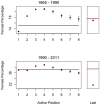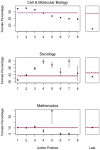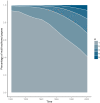The role of gender in scholarly authorship
- PMID: 23894278
- PMCID: PMC3718784
- DOI: 10.1371/journal.pone.0066212
The role of gender in scholarly authorship
Abstract
Gender disparities appear to be decreasing in academia according to a number of metrics, such as grant funding, hiring, acceptance at scholarly journals, and productivity, and it might be tempting to think that gender inequity will soon be a problem of the past. However, a large-scale analysis based on over eight million papers across the natural sciences, social sciences, and humanities reveals a number of understated and persistent ways in which gender inequities remain. For instance, even where raw publication counts seem to be equal between genders, close inspection reveals that, in certain fields, men predominate in the prestigious first and last author positions. Moreover, women are significantly underrepresented as authors of single-authored papers. Academics should be aware of the subtle ways that gender disparities can occur in scholarly authorship.
Conflict of interest statement
Figures





Similar articles
- Gender differences in authorships are not associated with publication bias in an evolutionary journal.PLoS One. 2018 Aug 29;13(8):e0201725. doi: 10.1371/journal.pone.0201725. eCollection 2018.PLoS One. 2018.PMID: 30157231Free PMC article.
- Gender Differences in the Authorship of Original Research in Pediatric Journals, 2001-2016.J Pediatr. 2017 Dec;191:244-249.e1. doi: 10.1016/j.jpeds.2017.08.044. Epub 2017 Oct 12.J Pediatr. 2017.PMID: 29033241
- Gender Trends in Authorship in Psychiatry Journals From 2008 to 2018.Biol Psychiatry. 2019 Oct 15;86(8):639-646. doi: 10.1016/j.biopsych.2019.02.010. Epub 2019 Feb 19.Biol Psychiatry. 2019.PMID: 30935668Free PMC article.
- Gender in authorship and editorship in medical education journals: A bibliometric review.Med Educ. 2021 Jun;55(6):678-688. doi: 10.1111/medu.14427. Epub 2020 Dec 15.Med Educ. 2021.PMID: 33258140Review.
- Stroke and myocardial infarction: a comparative systematic evaluation of gender-specific analysis, funding and authorship patterns in cardiovascular research.Cerebrovasc Dis. 2011;31(4):373-81. doi: 10.1159/000323258. Epub 2011 Jan 19.Cerebrovasc Dis. 2011.PMID: 21252506Review.
Cited by
- The Future of Women in Psychological Science.Perspect Psychol Sci. 2021 May;16(3):483-516. doi: 10.1177/1745691620952789. Epub 2020 Sep 9.Perspect Psychol Sci. 2021.PMID: 32901575Free PMC article.
- Women in evolution - highlighting the changing face of evolutionary biology.Evol Appl. 2015 Dec 19;9(1):3-16. doi: 10.1111/eva.12343. eCollection 2016 Jan.Evol Appl. 2015.PMID: 27087836Free PMC article.
- Self-citation is the hallmark of productive authors, of any gender.PLoS One. 2018 Sep 26;13(9):e0195773. doi: 10.1371/journal.pone.0195773. eCollection 2018.PLoS One. 2018.PMID: 30256792Free PMC article.
- Gender Differences in Research Productivity among Academic Psychiatrists in Canada.Can J Psychiatry. 2019 Jun;64(6):415-422. doi: 10.1177/0706743718802798. Epub 2019 Jan 7.Can J Psychiatry. 2019.PMID: 30616409Free PMC article.
- Network analysis of the social and demographic influences on name choice within the UK (1838-2016).PLoS One. 2018 Oct 31;13(10):e0205759. doi: 10.1371/journal.pone.0205759. eCollection 2018.PLoS One. 2018.PMID: 30379928Free PMC article.
References
- West MS, Curtis JW (2006) AAUP faculty gender equity indicators 2006. Technical report, American Association of University Professors.
- National Research Council (2010) Gender Differences at Critical Transitions in the Careers of Science, Engineering, and Mathematics Faculty. National Academies Press.
- Conley D, Stadmark J (2012) Gender matters: A call to commission more women writers. Nature 488: 590. - PubMed
- Waltman L (2012) An empirical analysis of the use of alphabetical authorship publishing. Journal of Informetrics 6: 700–711.
Publication types
MeSH terms
LinkOut - more resources
Full Text Sources
Other Literature Sources
Miscellaneous

